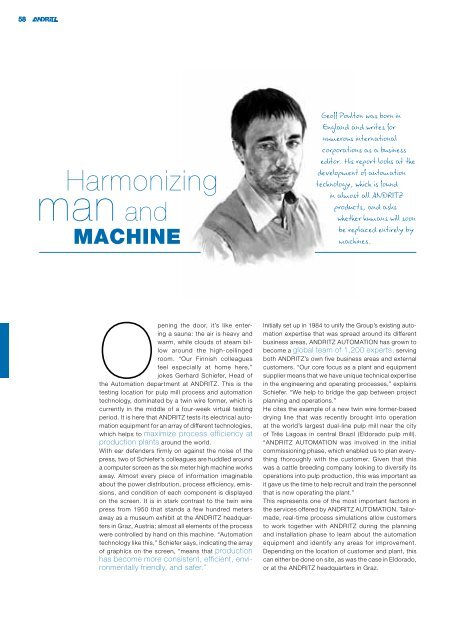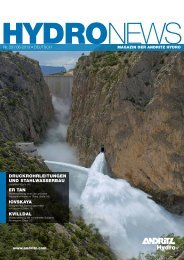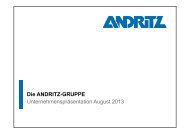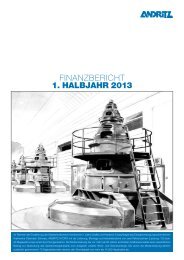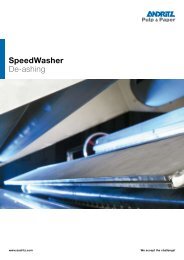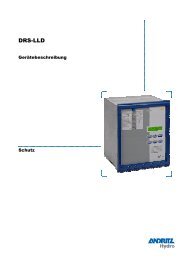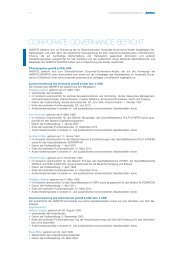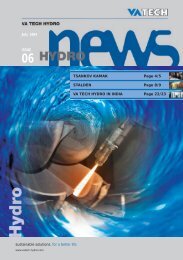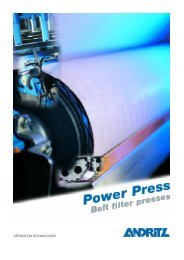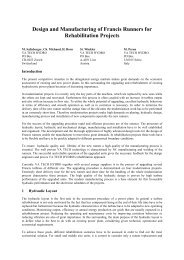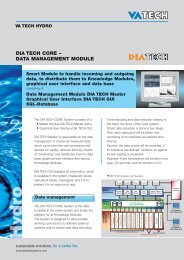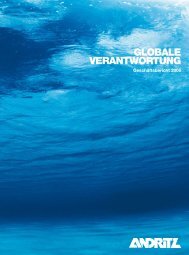ANDRITZ annual report 2012 - ANDRITZ Vertical volute pumps
ANDRITZ annual report 2012 - ANDRITZ Vertical volute pumps
ANDRITZ annual report 2012 - ANDRITZ Vertical volute pumps
You also want an ePaper? Increase the reach of your titles
YUMPU automatically turns print PDFs into web optimized ePapers that Google loves.
58<br />
Harmonizing<br />
man and<br />
machine<br />
Geoff Poulton was born in<br />
England and writes for<br />
numerous international<br />
corporations as a business<br />
editor. His <strong>report</strong> looks at the<br />
development of automation<br />
technology, which is found<br />
in almost all <strong>ANDRITZ</strong><br />
products, and asks<br />
whether humans will soon<br />
be replaced entirely by<br />
machines.<br />
Opening the door, it’s like entering<br />
a sauna: the air is heavy and<br />
warm, while clouds of steam billow<br />
around the high-ceilinged<br />
room. “Our Finnish colleagues<br />
feel especially at home here,”<br />
jokes Gerhard Schiefer, Head of<br />
the Automation department at <strong>ANDRITZ</strong>. This is the<br />
testing location for pulp mill process and automation<br />
technology, dominated by a twin wire former, which is<br />
currently in the middle of a four-week virtual testing<br />
period. It is here that <strong>ANDRITZ</strong> tests its electrical automation<br />
equipment for an array of different technologies,<br />
which helps to maximize process efficiency at<br />
production plants around the world.<br />
With ear defenders firmly on against the noise of the<br />
press, two of Schiefer’s colleagues are huddled around<br />
a computer screen as the six meter high machine works<br />
away. Almost every piece of information imaginable<br />
about the power distribution, process efficiency, emissions,<br />
and condition of each component is displayed<br />
on the screen. It is in stark contrast to the twin wire<br />
press from 1950 that stands a few hundred meters<br />
away as a museum exhibit at the <strong>ANDRITZ</strong> headquarters<br />
in Graz, Austria; almost all elements of the process<br />
were controlled by hand on this machine. “Automation<br />
technology like this,” Schiefer says, indicating the array<br />
of graphics on the screen, “means that production<br />
has become more consistent, efficient, environmentally<br />
friendly, and safer.”<br />
Initially set up in 1984 to unify the Group’s existing automation<br />
expertise that was spread around its different<br />
business areas, <strong>ANDRITZ</strong> AUTOMATION has grown to<br />
become a global team of 1,200 experts, serving<br />
both <strong>ANDRITZ</strong>’s own five business areas and external<br />
customers. “Our core focus as a plant and equipment<br />
supplier means that we have unique technical expertise<br />
in the engineering and operating processes,” explains<br />
Schiefer. “We help to bridge the gap between project<br />
planning and operations.”<br />
He cites the example of a new twin wire former-based<br />
drying line that was recently brought into operation<br />
at the world’s largest dual-line pulp mill near the city<br />
of Três Lagoas in central Brazil (Eldorado pulp mill).<br />
“<strong>ANDRITZ</strong> AUTOMATION was involved in the initial<br />
commissioning phase, which enabled us to plan everything<br />
thoroughly with the customer. Given that this<br />
was a cattle breeding company looking to diversify its<br />
operations into pulp production, this was important as<br />
it gave us the time to help recruit and train the personnel<br />
that is now operating the plant.”<br />
This represents one of the most important factors in<br />
the services offered by <strong>ANDRITZ</strong> AUTOMATION. Tailormade,<br />
real-time process simulations allow customers<br />
to work together with <strong>ANDRITZ</strong> during the planning<br />
and installation phase to learn about the automation<br />
equipment and identify any areas for improvement.<br />
Depending on the location of customer and plant, this<br />
can either be done on site, as was the case in Eldorado,<br />
or at the <strong>ANDRITZ</strong> headquarters in Graz.


